Many pasta dishes claim to be comforting, but a well-made chicken fettuccine alfredo delivers it in every bite.
The sauce is silky, buttery, and rich with garlic and Parmesan, coating each strand of pasta in creamy decadence.
Tender golden chicken slices bring hearty balance, while fresh parsley and extra cheese finish it with brightness. This is the kind of meal that turns an ordinary evening into something special.
The Essential Ingredients That Make Alfredo Exceptional
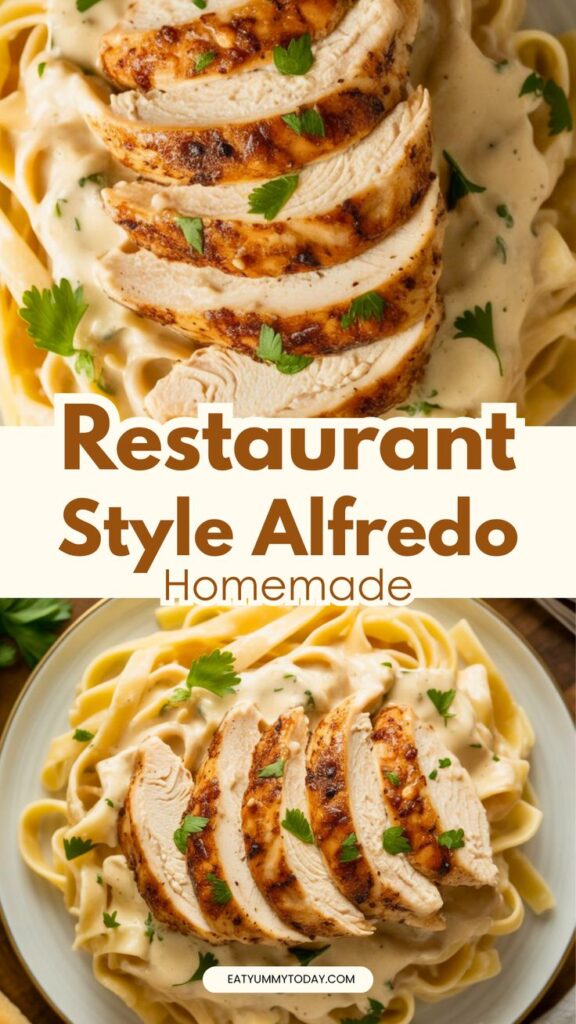
Classic Alfredo relies on a few simple, high-quality ingredients. Fettuccine is the traditional pasta of choice because its wide ribbons catch the creamy sauce better than spaghetti or penne.
Using unsalted butter allows control over the seasoning, while olive oil adds a layer of flavor when searing the chicken.
Heavy cream is the backbone of the sauce, giving it its luscious texture. Parmesan cheese provides a salty, nutty richness that balances the buttery cream.
Fresh garlic infuses aroma and sharpness, while parsley brightens the plate with color and freshness. With only a handful of pantry staples, this recipe transforms into something restaurant-worthy.
Choosing and Preparing the Chicken
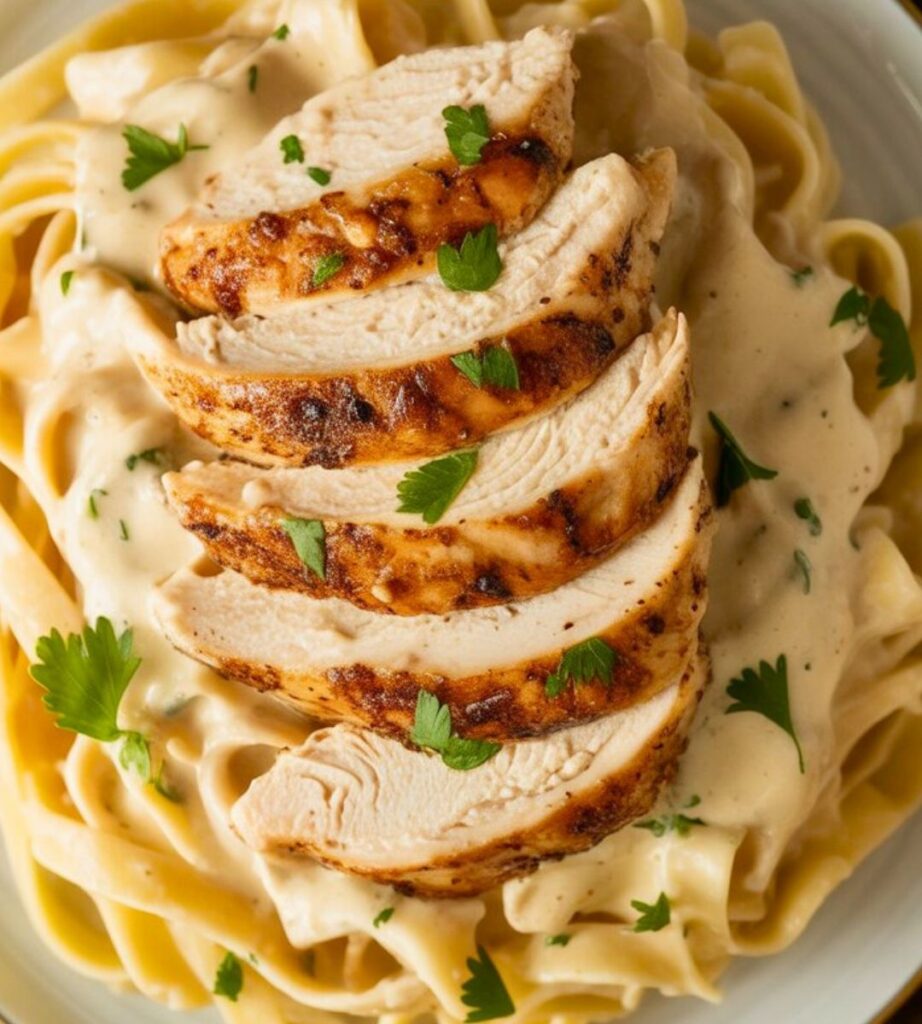
For the protein, boneless, skinless chicken breasts work best because they stay juicy when cooked properly and slice neatly over pasta. Before hitting the skillet, seasoning with salt and freshly ground black pepper is essential.
A hot pan with olive oil and a pat of butter ensures golden, flavorful crust while locking in juices.
The key is patience: sear the chicken first without moving it too much, then cover and finish cooking gently. Tent the chicken with foil while you prepare the sauce. This rest period keeps the meat tender and makes it easier to slice.
When plated, the strips add both flavor and visual appeal.
Building the Perfect Alfredo Sauce
The difference between a mediocre Alfredo and an unforgettable one comes down to technique. Begin by melting butter and sautéing garlic briefly—just enough to release fragrance without browning.
Adding flour at this stage forms a roux, which stabilizes the sauce and prevents separation later.
When whisking in the heavy cream, go slowly and keep stirring. This prevents lumps and ensures the sauce stays velvety. Allow it to gently simmer until it coats the back of a spoon.
At this point, Parmesan goes in, melting into the cream for a luxurious finish. Taste before serving; the right balance of salt and pepper is crucial.
Pasta Cooking Tips for Best Results
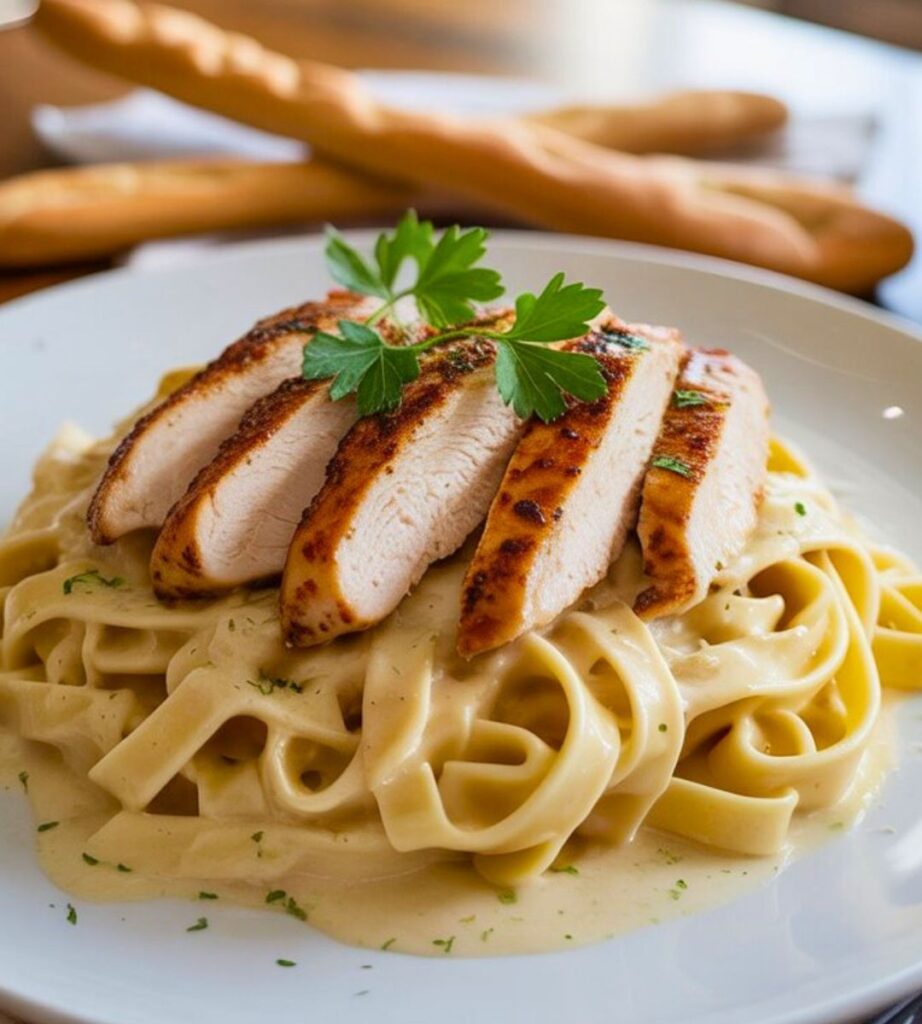
Cooking pasta properly makes all the difference. Always start with a large pot of boiling water seasoned generously with salt—this is your only chance to flavor the pasta itself.
For fettuccine, aim for al dente texture: tender but with a slight bite. Overcooked pasta will collapse under the weight of Alfredo sauce.
Once drained, toss the pasta with a drizzle of olive oil if you’re not serving immediately.
This prevents sticking. If you prefer a creamier presentation, you can also stir the pasta directly into the sauce before plating, ensuring every strand is coated. Both methods work—choose depending on whether you want a rustic or refined style.
Smart Substitutions and Variations
This recipe stays true to tradition, but it’s also flexible. If you prefer a lighter option, half-and-half can replace heavy cream, though the sauce will be thinner.
For cheese, Pecorino Romano offers a sharper, saltier punch compared to Parmesan.
Vegetarians can skip the chicken and add sautéed mushrooms, broccoli florets, or roasted red peppers instead. For extra protein, grilled shrimp pairs beautifully with Alfredo.
Gluten-free eaters can swap in a good-quality gluten-free fettuccine and a rice flour roux. These small changes allow you to make the dish your own while keeping its creamy essence.
How to Serve for Maximum Impact
Presentation matters with a dish this indulgent. A wide shallow bowl showcases the silky noodles and gives space for chicken slices to fan across the top.
A generous ladle of Alfredo sauce should pool over the pasta but not drown it. Sprinkle with chopped parsley for a pop of green and finish with a snowfall of freshly grated Parmesan.
Pairing the dish with a crisp green salad and a loaf of crusty bread balances the richness. A glass of chilled white wine such as Pinot Grigio or Chardonnay complements the creamy sauce.
For non-alcoholic options, sparkling water with a wedge of lemon refreshes the palate beautifully.
Storage and Reheating Tips
Alfredo is best enjoyed immediately, but leftovers can still be satisfying if stored properly.
Place cooled pasta in an airtight container and refrigerate for up to 3 days. The sauce will thicken when cold, so reheating requires a gentle touch.
Warm leftovers in a skillet over low heat with a splash of milk or cream to loosen the sauce. Avoid the microwave if possible, since it can cause the chicken to dry out and the sauce to separate.
If reheating in the microwave is necessary, use short bursts and stir frequently.
Troubleshooting Common Mistakes
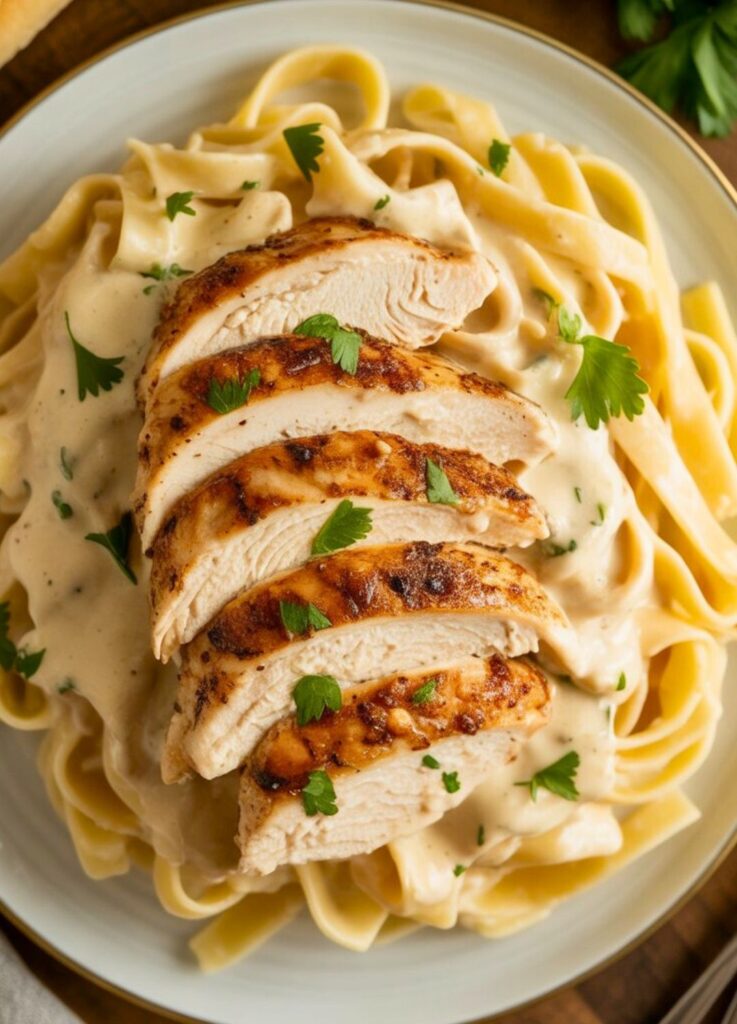
A few pitfalls can derail Alfredo if you’re not careful. If the sauce is too thin, let it simmer a little longer to reduce naturally; avoid adding too much flour, which can make it pasty.
If it becomes too thick, whisk in a splash of pasta water to bring it back to silky smoothness.
Grainy sauce usually means the cheese was added at too high a temperature. To fix this, remove the pan from the heat before stirring in Parmesan, letting residual warmth melt it gently.
And if the chicken seems dry, it was likely overcooked—next time, monitor closely and allow it to rest before slicing.
Nutrition Notes
This is a rich dish, no denying it, but portion control makes it manageable. A serving provides protein from the chicken, calcium from the cheese, and satisfaction from healthy fats in butter and cream.
To lighten the plate, pair smaller servings of Alfredo with a big bowl of vegetables or a fresh side salad. For those tracking intake, consider using whole-wheat fettuccine to add extra fiber and balance the meal.
Rich, indulgent, and deeply satisfying, this creamy chicken fettuccine alfredo deserves a place in your home kitchen rotation.
It’s the kind of pasta that turns dinner into a celebration without needing complicated steps or specialty ingredients. Serve it hot, showered with Parmesan, and enjoy the comforting luxury of every forkful.
Frequently Asked Questions About Creamy Chicken Fettuccine Alfredo
Can I use a different type of pasta instead of fettuccine?
Yes, you can substitute fettuccine with linguine, spaghetti, or even penne. The sauce pairs well with most pasta shapes, though fettuccine is traditional for Alfredo.
How can I make this dish lighter?
To reduce richness, substitute half of the heavy cream with whole milk or use half-and-half. You may also cut back slightly on the butter and cheese without losing too much flavor.
Can I prepare the sauce in advance?
It is best to serve Alfredo sauce fresh, as it can thicken and separate when reheated. If you must make it ahead, store it in an airtight container in the refrigerator and reheat gently over low heat while whisking.
What can I use instead of chicken?
Shrimp, salmon, or sautéed vegetables such as mushrooms, broccoli, or spinach make excellent alternatives. These variations allow the Alfredo sauce to remain the centerpiece of the dish.
How do I prevent the sauce from curdling?
Keep the heat low once the cream is added, and whisk continuously. Avoid boiling the sauce, as high heat can cause the dairy to separate.
Can this recipe be made gluten-free?
Yes. Use gluten-free pasta and replace the all-purpose flour with a gluten-free thickener such as cornstarch or rice flour.
How long will leftovers last?
Leftovers can be refrigerated in an airtight container for up to 3 days. Reheat slowly on the stovetop with a splash of milk or cream to restore creaminess.
What side dishes go well with Chicken Alfredo?
Garlic bread, Caesar salad, or roasted vegetables complement this dish well by adding freshness and balance to the creamy pasta.
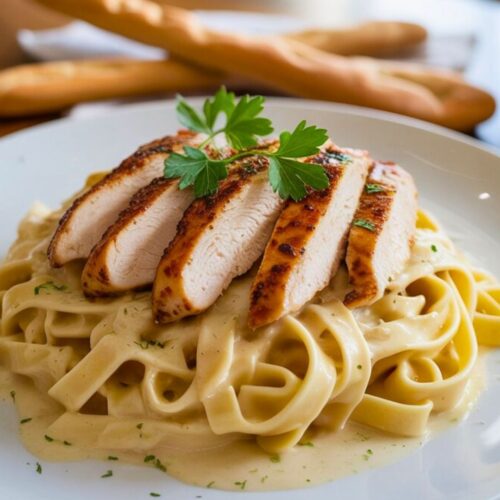
Creamy Chicken Fettuccine Alfredo
Ingredients
Main Ingredients
- 12 oz dry fettuccine pasta
- 2 tbsp olive oil
- ¾ cup unsalted butter divided
- 2 boneless, skinless chicken breasts
- 1 ½ tsp salt divided
- 1 ½ tsp freshly ground black pepper divided
- 4 cloves garlic finely minced
- 2 tbsp all-purpose flour
- 2 ⅓ cups heavy cream
- 1 cup grated Parmesan cheese plus extra for serving if desired
- 1 tbsp fresh parsley chopped, for garnish
Instructions
Step-by-Step Instructions
- Fill a large pot with water, bring to a boil, and add a pinch of salt. Cook fettuccine according to package instructions until al dente. Drain and toss with a drizzle of olive oil if desired.
- Heat a large skillet over high heat. Add olive oil and 1/4 cup butter. Season chicken with half the salt and pepper. Cook chicken until golden on both sides, reduce heat to medium, cover, and cook 5 more minutes until cooked through. Transfer to a plate and tent with foil.
- In a clean skillet, melt remaining 1/2 cup butter over medium heat. Add minced garlic and sauté for 30 seconds until fragrant. Reduce heat to low, sprinkle in flour, and stir to form a smooth paste.
- Gradually whisk in heavy cream, keeping the sauce smooth. Cook on low heat until slightly thickened. Stir in 1/2 cup Parmesan cheese until melted and adjust seasoning with remaining salt and pepper.
- Slice the rested chicken into strips. Divide pasta among plates, top with chicken, and spoon Alfredo sauce generously over the top. Garnish with parsley and extra Parmesan. Serve immediately.
Notes
- Resting the chicken allows juices to redistribute, keeping it tender.
- Use freshly grated Parmesan for best flavor and smooth sauce texture.
Leave a Reply